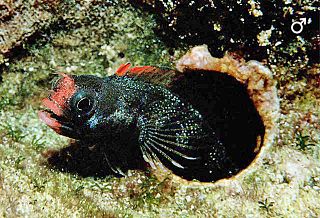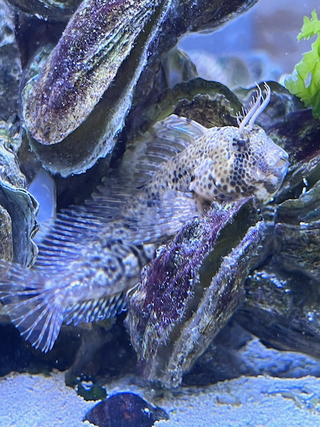
Combtooth blennies are blenniiformids; percomorph marine fish of the family Blenniidae, part of the order Blenniiformes. They are the largest family of blennies with around 401 known species in 58 genera. Combtooth blennies are found in tropical and subtropical waters in the Atlantic, Pacific and Indian Oceans; some species are also found in brackish and even freshwater environments.

Blenny is a common name for many types of fish, including several families of percomorph marine, brackish, and some freshwater fish sharing similar morphology and behaviour. Six families are considered "true blennies", grouped under the order Blenniiformes; its members are referred to as blenniiformids. About 151 genera and nearly 900 species have been described within the order. The order was formerly classified as a suborder of the Perciformes but the 5th Edition of Fishes of the World divided the Perciformes into a number of new orders and the Blenniiformes were placed in the percomorph clade Ovalentaria alongside the such taxa as Cichliformes, Mugiliformes and Gobiesociformes.

Malacoctenus is a genus of labrisomid blennies native to the eastern Pacific Ocean and the Atlantic Ocean.

Coralliozetus is a genus of chaenopsid blennies mostly found in the eastern Pacific Ocean with one species (C. cardonae) occurring in the western Atlantic Ocean. Additionally, one species (C. clausus) is endemic to Cocos Island, Costa Rica.

Salarias is a genus of combtooth blennies found in the Indian and Pacific oceans.

Ecsenius is a large genus of fish in the family Blenniidae. Several species, including Ecsenius midas, the Midas blenny, and Ecsenius bicolor, the bicolor blenny, are commonly sold at aquarium stores as pets.

Acanthemblemaria is a genus of chaenopsid blennies native to the Atlantic and Pacific Oceans.

Cirripectes is a large genus of combtooth blennies found throughout the Pacific and Indian oceans. Cirripectes biconvexus, an otolith based fossil species from the Burdigalian (Miocene) of southwestern India is probably the earliest record of this genus.

Hypleurochilus is a genus of combtooth blennies found throughout the Atlantic Ocean.

Hypsoblennius is a genus of combtooth blennies found in the Pacific and Atlantic Oceans.

Meiacanthus is a genus of combtooth blennies found in the western Pacific and Indian oceans. Many species in this genus make their way into the aquarium trade and several are venomous. The genus name Meiacanthus is derived from the Greek meion meaning "less" and akantha meaning "thorn" and refers to most species having relatively few dorsal fin spines.

Parablennius is a diverse genus of combtooth blennies found in the Atlantic, western Pacific, and Indian Ocean.
Stanulus seychellensis, the Seychelle's blenny, is a species of combtooth blenny found in coral reefs in the Pacific and Indian oceans. This species feeds primarily off of plants, including benthic algae and weeds. This species can reach a length of 4 centimetres (1.6 in) TL. This fish is also found in the aquarium trade.
Emblemaria is a genus of chaenopsid blennies found throughout the Pacific and Atlantic oceans.

Emblemariopsis is a genus of flagblennies found throughout the Atlantic ocean.

Lucayablennius zingaro, the arrow blenny, is a species of chaenopsid blenny found in coral reefs around the Bahamas and the Caribbean, in the western central Atlantic ocean. It can reach a maximum length of 3.8 centimetres (1.5 in) TL. This species is the only known member of its genus. They are red to reddish brown in color with white stripes that fade to yellow towards the tail. The tail is always held at a curve or bend and typically has three black spots on the dorsal side. Unlike most blennys, the arrow blenny does not perch its self on rocks or coral. Rather, it waits floating in the water column before swooping down to catch unsuspecting zooplankton.
Stathmonotus is a genus of chaenopsid blennies found in the Pacific and Atlantic oceans.

Paraclinus is a genus of labrisomid blennies native to eastern Pacific Ocean and the western Atlantic Ocean.

Starksia is a genus of labrisomid blennies native to the western Atlantic Ocean and the eastern Pacific Ocean. Their typical length is 2 cm (0.79 in) SL. The generic name honours the American ichthyologist Edwin Chapin Starks (1867-1932) of Stanford University for his work on Pacific coastal fishes. As a genus Starksia is distinguished from other labrisomids by their scaled bodies, two obvious soft rays in the pelvic fin and the male's have an intromittent organ which is near to or attached to the first spine of their anal fins, which is also somewhat separated from the fin.

Salarinae is one of two subfamilies in the combtooth blenny family Blenniidae, it is the largest of the two subfamilies in the Blennidae with 43 genera. The species in this subfamily are mainly marine, with a few species which are found in freshwater or brackish water, and a few species are known to spend much time out of the water.

















